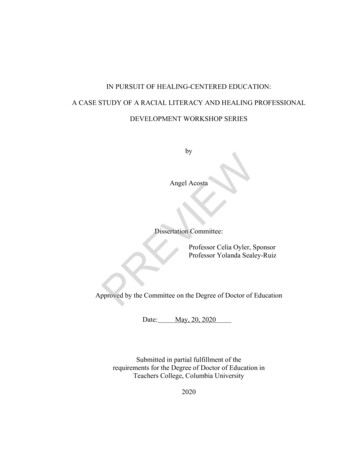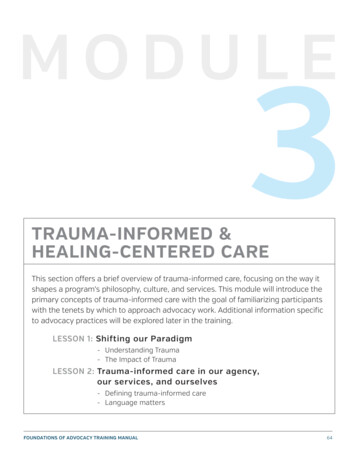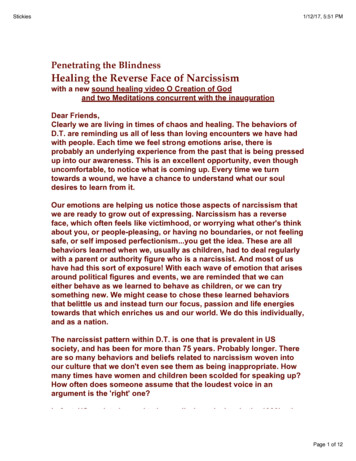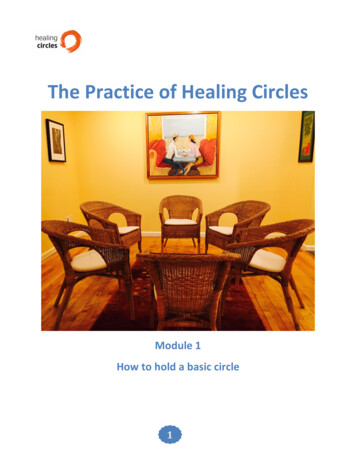
Transcription
IN PURSUIT OF HEALING-CENTERED EDUCATION:A CASE STUDY OF A RACIAL LITERACY AND HEALING PROFESSIONALDEVELOPMENT WORKSHOP SERIESWbyEVIEAngel AcostaDissertation Committee:PRProfessor Celia Oyler, SponsorProfessor Yolanda Sealey-RuizApproved by the Committee on the Degree of Doctor of EducationDate:May, 20, 20200Submitted in partial fulfillment of therequirements for the Degree of Doctor of Education inTeachers College, Columbia University2020
ProQuest Number: 27994499All rights reservedINFORMATION TO ALL USERSThe quality of this reproduction is dependent on the quality of the copy submitted.EVIEWIn the unlikely event that the author did not send a complete manuscriptand there are missing pages, these will be noted. Also, if material had to be removed,a note will indicate the deletion.ProQuest 27994499Published by ProQuest LLC ( 2020 ). Copyright of the Dissertation is held by the Author.PRAll Rights Reserved.This work is protected against unauthorized copying under Title 17, United States CodeMicroform Edition ProQuest LLC.ProQuest LLC789 East Eisenhower ParkwayP.O. Box 1346Ann Arbor, MI 48106 - 1346
ABSTRACTIN PURSUIT OF HEALING-CENTERED EDUCATION:A CASE STUDY OF A RACIAL LITERACY AND HEALING PROFESSIONALDEVELOPMENT WORKSHOP SERIESEVIEWAngel AcostaIn an attempt to tackle issues of racism in the U.S. public education system,school districts throughout the country are paying particular attention to how teachers andeducational leaders are trained and supported to address issues of racial disparities. As aresult of this, there has been a diffusion of various anti-bias and racial literacy-basedPRtrainings in some of the largest school systems. This dissertation explored a case study ofa unique racial literacy and healing professional development (PD) workshop serieswithin the New York City Department of Education, which was offered to a groupcomposed predominantly of educators of Color. This inquiry was primarily concernedwith how the educator of the PD workshop series designed and enacted a healingcentered pedagogy and what were the affordances of such an approach. A number ofqualitative research methods—including contemplative inquiry—worked together tounderstand how this professional learning experience enabled participants to engage in ahealing praxis. The PD curriculum structured opportunities for participants to deploy a
two-pronged healing praxis, which combined racial literacy and critical consciousness onone side, and healing and self-care on the other. Through the combination of atransformative activist stance, a healing-centered engagement, and an indigenist stance,this study drew on a unique conceptual framework to examine how the PD series enabledparticipants to: (a) surface feelings of racialized stress and trauma; (b) potentiate theirown healing journey; (c) articulate gratitude and cultivate empathy; and (d) exploreconflict and cultural fault lines. This work finds a home in the coming wave ofscholarship and a canon that considers healing within the context of education as anPREVIEWurgent matter.
WEVIE Copyright Angel Acosta 2020PRAll Rights Reservedii
TABLE OF CONTENTSChapter I – INTRODUCTION . 1Background of the Problem . 3Statement of the Problem . 9Rationale . 10Purpose of Study and Research Questions . 11Significance . 12Conceptual Framework . 12Overview . 19EVIEWChapter II – LITERATURE REVIEW. 21Healing-Centered Pedagogies within Indigenous Scholarship and Education. 22Healing-Centered Pedagogies within Higher Education . 26Healing-Centered Pedagogies within K-12 School Curricula . 29Healing-Centered Pedagogies within Community Organizing . 34Integrating the Threads of Healing-Centered Approaches . 36Weaving Healing-Centered Pedagogies with Racial Literacy . 38PRChapter III – METHODOLOGY . 44Context of the Study . 44Research Design Overview and Research Questions . 48Site Selection . 50Participant Selection . 52Data Collection . 53Contemplative Qualitative Inquiry . 54Inquiry Journal. 56Semi-Structured Interviews . 57Focus Groups . 59Document Review . 61Research Positionality . 61Methods of Analysis . 71Open Coding of Data . 72Contemplative Inquiry and Refining Data Analysis . 76Participant Interview Profiles and Workshop Vignettes . 80Trustworthiness . 81Limitations . 82Chapter IV – DEVELOPMENT OF A HEALING PRAXIS . 85Critical Consciousness and Racial Literacy as Praxis . 86An Engaged Pedagogy . 94iii
Chapter V – BY-PRODUCTS OF THE ENACTMENT OF A HEALINGCENTERED PEDAGOGY . 101Surfacing Feelings of Racialized Stress and Trauma . 102The Articulation of Gratitude and Cultivators of Empathy . 112Potentiating and Supporting Participants’ Healing Journeys . 116Exploring Conflict and Exposing Cultural Fault Lines . 119Chapter VI – DISCUSSION OF FINDINGS AND IMPLICATIONS . 130Summary of Findings . 130Reflection on Conceptual Framework . 132Interpretation(s) of Findings . 136Implications for Theory, Practice, and Policy . 143Limitations of the Study . 148Concluding Remarks: Teaching with a World on Fire . 151WREFERENCES . 153PREVIEAPPENDICESAppendix A Invitation to Study and Consent Form. 171Appendix B Participant Interview Protocol . 176Appendix C Workshop Series Educator Interview Protocol . 177Appendix D Focus Group Protocol . 178Appendix E Vignette of Workshop #1 . 179Appendix F Vignette of Workshop #2 . 183Appendix G Vignette of Workshop #3 . 186Appendix H PD Syllabus . 190Appendix I Self-Care Worksheets . 192Appendix J “Where I’m From” Prewriting Activity . 195Appendix K The 4 I’s of Oppression Worksheet . 196Appendix L Initial Codes from NVivo Software . 198Appendix M Codes from Participant Interviews . 204Appendix N Contemplate Sits and Walks with Data Protocol . 206Appendix O Racial Literacy Development Image . 207iv
LIST OF TABLESTablePageWorkshop Series Outline . 512Participant Grid . 523Sources of Data Grid . 54PREVIEW1v
LIST OF FIGURESFigurePageConceptual framework . 662Example of codes . 743Coding chart from first workshop . 754Conceptual framework . 134PREVIEW1vi
LIST OF IMAGESImagePageContemplative practices for data analysis . 772Scoring salient quotes from interview transcripts . 79PREVIEW1vii
1Chapter IINTRODUCTIONThe task of preparing educators to understand how racism works in schools has,in large part, been situated within university-based teacher preparation programs anduniversity-based educational leadership development programs (Brown, 2004; Gooden,W2012; Horsford, Grosland, & Gunn, 2011; Parsons, 2005; Rusch & Horsford, 2009). InEVIEthe case of teacher education, researchers have documented how programs struggle toequip teachers effectively with the skills needed to teach a diversifying studentpopulation and to dismantle long-standing racist policies and practices (Cochran-Smith,2004; Mosley & Rogers, 2011; Picower, 2009). Scholars in the subfield of educationalleadership have also examined the challenges that come with training and educatingPRsuperintendents, principals, deans, and other school staff to address issues concerningracism (Cambron-McCabe & McCarthy, 2005; Lightfoot, 2009; Rusch & Horsford,2008; Solomon, 2002). This study drew on the recent trend in the field of education thatfocuses on ensuring that teachers and educational leaders have the racial literacy andcultural competency to identify and interrupt personal prejudice and structural racism inschools (Bolgatz, 2005; Gillborn, 2014; Horsford, 2009).Rusch and Horsford (2008) asserted that aspiring educational leaders who feelunprepared to talk about race and who do not have access to opportunities to explorecomplex social justice issues constructively experience difficulties when leading indiverse contexts. There is a palpable sense of urgency toward building educators’
2competencies through different anti-bias, anti-racist, and racial literacy-basedprofessional development and leadership programs. The core assumption here is that byhelping educators to understand “what race is, why it is, and how it is used to reproduceinequality” (Horsford, 2011a, p. 95), they will develop the racial literacy and skills tointerrupt policies and practices that reinforce racism in schools (Gilborn, 2014).Fundamentally, this inquiry is influenced by three specific developments. First,some school districts throughout the country are providing opportunities for their leadersWand teachers to learn more about how to better address issues of racial disparitiesEVIE(Darling-Hammond, 2004; Horsford, 2010). Second, some of the challenges that comewith this task have given rise to the development of racial affinity groups to helpeducators discuss issues of race and racism in separate spaces (Bennett, Cole, &Thompson, 2000; Irizarry, 2007; Kohli, 2008, 2012; Kohli & Pizzaro, 2016). Third, therehas been an emergent focus on healing-centered pedagogies to support communitiesPRprocessing and recovering from racism, sexism, classism, and other forms ofinstitutionalized oppression (Ginwright, 2015, 2018).Correspondingly, this is a case study on the design, implementation, and impactof a racial literacy-based and healing-centered professional development (PD) workshopseries within the New York City Department of Education (NYC DOE) that wasprovided for educators of Color in the fall of 2019. My research closely examined a NYCDOE-sponsored educator affinity group—the Male Educators Collective (MEC)—as itsmembers participated in an intentionally curated professional learning experience. Toprotect participants’ identities, the names Cindy Bailey-Cruz and MEC are used aspseudonyms. As I briefly mentioned, school districts are investing significant money and
3energy in deploying different strategies to address issues of equity. The MEC representsone of many opportunities the NYC DOE has provided to support educators with tacklingissues of racial disparities.Background of the ProblemThe problem of the twentieth century is the problem of thecolorline. (Du Bois, 1903)EVIEWThe unique combination of American terrorism—Jim Crow andlynching—as well as American barbarism—slave trade and slave labor—bears witness to the distinctive American assault on black humanity. Thisvicious ideology and practice of white supremacy has left its indeliblemark on all spheres of American life—from the prevailing crimes ofAmerindian reservations to the discriminatory realities against Spanishspeaking Latinos to racial stereotypes against Asians.In this sense, theproblem of the twenty-first century remains the problem of the colorline.(West, 1993)In 2019, issues concerning race and racism remained intractable throughout U.S.PRculture and society. Exactly 400 years after the arrival of enslaved Africans toJamestown, Virginia, the racial fault lines within the United States of America were stillwide and exposed. Various scholars have suggested that the system of slavery neverended; rather, it transmuted into more sophisticated mechanisms of control andstratification (Alexander, 2010; Coates, 2014; Du Bois, 1903; Ladson-Billings, 2006;West, 1993). For many of these researchers, the prison-industrial complex, votersuppression, the wealth gap, the opportunity gap in education, and pervasive policebrutality represented some of the ways the aftermath of slavery manifests itself incontemporary American society.
4The further entrenchment of racial stratification and the resulting inequalityimpact the life trajectories of not only African Americans, but other minoritized groups aswell. In many ways, the United States has had to deal with the ramifications of itsencoded and institutionalized form of racialized hierarchy. For example, it has wrestledwith the byproducts of what many scholars considered to be the failure of integrationafter Brown v. Board of Education (Horsford, 2011a; Ladson-Billings, 2004; Ogletree,2004). Scholars have documented how the process of desegregation resulted in failedWefforts to truly integrate schools in a way that went beyond just dismantling the legalEVIEbarriers that separated the races, but to thoroughly ensuring a fair and just distribution ofresources in the nation’s schools (Bell, 1992; Guinier, 2004).In her book Learning in a Burning House: Educational Inequality, Ideology, and(Dis)Integration, Sonya Horsford (2011a) provided an examination of the negativeconsequences of school desegregation on Black communities in the United States. HerPRwork illuminated how the legal effort to desegregate and integrate the nation’s schoolsystems was thwarted, stalled, and derailed by the persistence of racist ideologies and thepermanence of structural racism itself (Horsford, 2011a). Furthermore, the U.S. educationsystem as a whole has had to respond to the demographic shifts in its population. Thecurrent student population in schools throughout the country is representative of variousethnic and cultural backgrounds (Anderson, 2003; Johnson, 2019; Noguera, 2003, 2009).Many school districts are overwhelmed with the influx of students with complex cultural,linguistic, economic, and health needs (Howard, 2007; Johnson, 2019). Presently, thepopulation of the U.S. teaching workforce is predominantly composed of White femaleteachers. Less than 10% of the teaching workforce is constituted of teachers of Color
5(Carter-Andrews et al., 2019). This reality also has propelled scholars to study theabsence of teachers of Color in classrooms, and the various issues relating to theirretention, professional development, and turnover (Achinstein, Ogawa, Sexton, & Freitas,2010; Bristol & Shirrell, 2018; Carter-Andrews et al., 2019; Kholi, 2018).At the same time, a plethora of scholarship and educational initiatives hasemerged to understand and support teachers and educational leaders who are tasked witheducating a diversifying student population and addressing issues racial disparities.WResearch on the demographic changes and present educational inequalities confirmedEVIEhow institutionalized racism within school communities continues to constrain efforts toeducate all children, especially children of Color, in more equitable ways (Alexander,2010; Ladson-Billings, 2000; Payne, 2008; Sizemore, 2008). Fundamentally, racism stillplays a debilitating role in how schooling is experienced and administered. Schoolcommunities that are predominantly populated by students of Color experience aPRdisproportionate distribution of school funding (Anyon, 1997; Gooden, 2012); overtlypunitive school discipline (McKintosh et al., 2018); disproportional labeling of studentswith disabilities (Green, Cohen, & Stormont, 2019); and truncated access topostsecondary education (Hung et al., 2020). This disproportionality experienced incommunities of Color in relation to education is a byproduct of centuries of systemic andstructural inequality.Evidently, legislation to desegregate and integrate schools over the last halfcentury represents legal efforts to create a more equitable schooling experience for allAmericans. Yet, these legal strategies did not do enough to level the playing field (Wells,Duran, & White, 2008). In addition to legislation, a variety of curriculum-based
6interventions have emerged to address racial disparities in schools. In particular, over thelast decade, educational leaders have recognized the importance of advancing policiesthat increase educational access and equity, especially for communities of Color (Khalifa,Gooden, & Davis, 2016). These efforts somewhat reflect a recognition that the currentsocioeconomic conditions that limit social mobility and further cement the opportunitygap in education need to be urgently addressed. Scholars in the field of education havecreated curricula and academic departments that aimed to address the needs of anWevolving multicultural society riddled with racism, sexism, classism, ableism, and otherEVIEforms of discrimination. For example, the evolution of multicultural education (Banks,2004; Nieto, 1999; Shannon-Baker, 2018; Sleeter, 2018), social justice education (Parker& Villalpando, 2007), culturally relevant pedagogy (Gay, 2010; Irvine, 2010; LadsonBillings, 1995b), critical pedagogy (Darder, Baltodano, & Torres, 2003; Duncan-Andrade& Morrell, 2008; Freire, 2007), and racial literacy-based education (Bolgatz, 2005;PRHorsford, 2009) have emerged to equip teachers and school leaders with the strategiesand knowledge base to combat institutionalized racism and other forms of oppression inschools and communities. These approaches to education have made their impact on thepublic school system in myriad ways. In particular, school systems like the NYC DOEhave provided its educational leaders and teachers with professional development (PD)opportunities that deepen their understanding of race and racism through anti-bias, antiracist, and racial literacy-based trainings.With the help of university-based partnerships and educational consultants, schoolsystems throughout the country have offered a variety of PD opportunities to its staff.This case study examined a professional learning experience curated and sponsored by
7the Male Educators Collective (MEC), a program within the NYC DOE. MEC partneredwith a professor from a private university and educational consultant, Dr. Cindy BaileyCruz, to facilitate and host a racial literacy and healing PD workshops series. Dr. BaileyCruz was a university-based scholar who had spent the last decade teaching about theeffects of racial divisiveness and institutionalized racism in the context of education. Icame to learn about her work and the PD workshop series through my relationship withher as a former student of hers. I viewed the PD workshop series and MEC as a uniqueWdevelopment that aligned with my research interest. I explore this synergy in more lengthEVIEin Chapter III.The partnership between the MEC and Dr. Bailey-Cruz is connected to the recenthistory and developments within Mayor Bill de Blasio’s Equity and Excellence mandateand former mayor Mike Bloomberg’s education agenda. In terms of the de Blasioadministration, the component within the mandate that is of interest here is the fact that itPRprovided more access to PD to help with implementing and integrating equity-basedleadership and instructional practices. More specifically, the Chancellor of the NYCDOE—Richard Carranza—committed an additional 23 million dollars to pay for antibias trainings for the next 4 years (Veiga, 2018). These trainings would be mandatory forevery employee who works with students in the system. Carranza and the de Blasioadministration were attempting to ensure that students were being well-served, and thatteachers and school leaders were equipped with the skills to educate a more diversepopulation. By the end of 2019, the NYC DOE expected to train 10,000 employees andreach the rest of the department by 2022 (Disare, 2018; Veiga, 2018). The central goal ofthis effort was to help the system as a whole to dig more deeply into data and practices to
8uncover and address racial inequities. This increase in funding for anti-bias training alsobrought about more support for initiatives like the Male Educators Collective. Thisinitiative aimed, primarily, to increase the small number of males of Color who served asteachers in NYC public schools. It also provided a mentoring program and curated PDworkshops on culturally responsive teaching practices and racial literacy-based educationto its male members, but it also invited other educators to participate in theseopportunities and in the MEC community. In a sense, the program cultivated anWecosystem that supported teachers of Color in particular, but also invited all educatorsEVIEinterested in issues of racial equity to come together to build cultural competency andresiliency. Again, although its mission was focused on supporting men of Color in theteaching profession, many of its professional learning experiences and community eventswere open to all educators who were interested in learning more about racial disparities.In early February of 2019, MEC and Dr. Bailey-Ruiz launched the RacialPRLiteracy and Healing Professional Development Workshop Series. The curriculum wasdesigned to explicitly center the lives and experiences of educators of Color. Thisinaugural series was comprised of five day-long workshops. It was hosted at a privateuniversity in the NYC region, where Dr. Bailey-Cruz taught. The series invitedparticipants to reflect on their experiences as leaders and teachers of Color and providedthem with an opportunity to discuss issues of race, racism, racial literacy, and healing.After a successful inaugural series, MEC and Dr. Bailey-Cruz decided to host a secondround of workshops addressing similar themes. This case study looked at what transpiredduring the second installment of the racial literacy and healing PD workshop series.
9Statement of the ProblemThe NYC DOE’s efforts to educate its teachers and leaders about how to disruptracism is a crucial step toward addressing pervasive racial inequalities in the system.Access to anti-bias, anti-racist, and racial literacy-based trainings and workshops have, onsome levels, advanced the conversation on racial equity. One of the major contributionsof this work is the discussion of how Whiteness and White Supremacy reinforce racismWin schools (DiAngelo, 2011; Howard, 2006; Leonardo, 2002; Margolin, 2015; Picower,2009). Many of the anti-bias and racial literacy-based trainings made available toEVIEeducators have exposed participants to conversations about unearned privilege, Whitefragility, and Whiteness as a form of property and cultural capital (Leonardo &Zembylas, 2013). This is a step in the right direction for a school system that is takingconcerted efforts to transform itself. However, most of these PD opportunities arePRdesigned, often unintentionally, to support White educators with having courageousconversations about racism (Singleton & Linton, 2006).In both teacher preparation programs (Cochran-Smith, 2004; Nieto, 2000;Picower, 2009) and within educational leadership programs (Cambron-McCabe &McCarthy, 2005; Rusch & Horsford, 2008; Solomon, 2002), there is evidence of thebenefits and challenges to teaching White educators how they are implicated in howracism works inside and outside of schools (Leonardo, 2002). Within these programs,educators of Color often end up lifting the emotional weight during conversations aboutracism and feel unsupported afterwards (Leonardo, 2004; Sleeter, 2008). Criticalconversations about racism—that are often revelatory and transformative for some White
10educators—leave educators of Color drained (Bennett et al., 2000; Irizarry, 2007; Kohli,Nevárez, & Arteaga, 2018). For many educators of Color, these kinds of programs,trainings, and PD experiences trigger trauma from past overt and subtle racist acts, and, attimes, incite racial battle fatigue (Smith et al., 2006). This reality has given rise to newscholarship on racial affinity groups in education, primarily to support teachers of Colorwith navigating racist public school systems (Kohli, 2012; Matias, 2013; Pour-Khorshid,2016; Sleeter, Neal, & Kumashiro, 2014). Research on teachers of Color has pointed to aWgrowing hostile racial climate within school systems (Jayakumar, Howard, Allen, & Han,EVIE2009). This case study on the MEC’s professional development workshop series issituated within a growing interest in exploring professional learning spaces thatspecifically aim to support teachers of Color. The PD series deliberately carved out anopen space to center the lived experiences of educators of Color, while supporting themwith exploring issues of racial literacy and racism through what seemed to be a healing-PRcentered curriculum. My core research questions were organized around this notion of a“healing-centered” approach.RationaleAgain, within education systems like the NYC DOE, there is a growingcommitment to addressing issues of racial disparities. The rapidly diversifying studentpopulation, the persistent gaps in educational opportunity, and a predominantly Whiteteacher workforce propel educational leaders throughout the country to find ways toaddress these problems with various reforms. One of the elements of these reforms is theuse of professional and leadership development as a mechanism to produce change.
11However, a growing body of work reveals how education and training on issues of raceneed to be differentiated for educators, especially educators of Color who frequentlyexperience the intensity of racism directly on a daily basis (Kohli, 2018). Professionaldevelopment, teacher preparation, and educational leadership programs that attempt tohelp educators deepen their understanding of how racism works are often insufficient inproviding educators of Color with the support, knowledge, skills, and insights they needto navigate school systems riddled with racial disparities. As education systems continueWto invest heavily in PD to reduce racial disparities and provid
IN PURSUIT OF HEALING-CENTERED EDUCATION: A CASE STUDY OF A RACIAL LITERACY AND HEALING PROFESSIONAL DEVELOPMENT WORKSHOP SERIES by Angel Acosta Dissertation Committee: Professor Celia Oyler, Sponsor Professor Yolanda Sealey-Ruiz Approved by the Committee on the Degree of Doctor of Education










